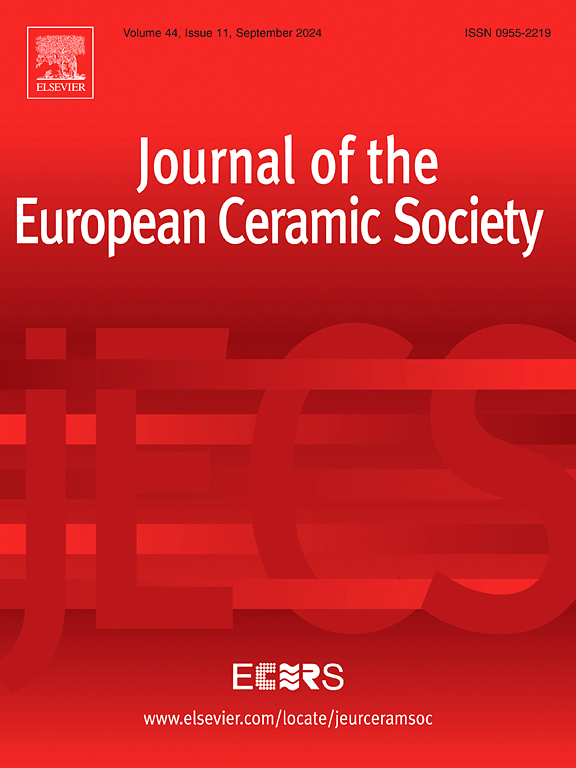胶体二氧化硅作为压制氧化镁结构的抗羟基化粘合剂
IF 5.8
2区 材料科学
Q1 MATERIALS SCIENCE, CERAMICS
Journal of The European Ceramic Society
Pub Date : 2025-05-07
DOI:10.1016/j.jeurceramsoc.2025.117517
引用次数: 0
摘要
用于炼钢的镁砖在安装前需要热固性树脂基粘合剂和1400℃以上的预烧结步骤,以确保强度和尺寸稳定性。用水性粘合剂代替树脂和采用更短的烧结时间表将节省能源。作者的研究将MgO颗粒和硅化二氧化硅胶体水相分散在自流动悬浮液中,减少了羟基化损伤,提高了烧结前后的强度。本研究评估了在压制系统中相同的原材料组合。用胶体二氧化硅(0-0.04 SiO2-MgO摩尔比)喷射细粒MgO,采用常规单轴压成形。在MgO颗粒表面形成一层薄薄的水合硅酸镁(4MgO.5SiO2·H2O)涂层,防止羟基化损伤。在烧结过程中,它软化并成为无定形二氧化硅和Forsterite (Mg2SiO4)的混合物。与不含二氧化硅的参考材料相比,含有二氧化硅胶体的样品在较低温度下烧结后,绿色强度增加了两到三倍,致密化程度更高。本文章由计算机程序翻译,如有差异,请以英文原文为准。
Colloidal silica as an anti-hydroxylation binder for pressed MgO structures
MgO-bricks for steelmaking require thermoset resin-based binders and pre-sintering steps above 1400ºC before installation to ensure strength and dimensional stability. Replacing resins with aqueous-based binders and employing shorter sintering schedules would save energy. An authors' study combined MgO particles and aqueous dispersion of silanized colloidal silica in a self-flowing suspension, reducing hydroxylation damages and improving strength before and after sintering. This study evaluated the same combination of raw materials in a pressed system. Fine MgO was sprayed with colloidal silica (0–0.04 SiO2-MgO molar ratio) and shaped by conventional uniaxial pressing. A thin magnesium silicate hydrate (4MgO.5SiO2·H2O) coating formed at the surfaces of MgO particles and prevented hydroxylation damage. During sintering, it softened and became a mixture of amorphous silica and Forsterite (Mg2SiO4). Compared to the silica-free reference, samples containing colloidal silica showed a two-to-three-fold green strength increase and higher densification levels after sintering at lower temperatures.
求助全文
通过发布文献求助,成功后即可免费获取论文全文。
去求助
来源期刊

Journal of The European Ceramic Society
工程技术-材料科学:硅酸盐
CiteScore
10.70
自引率
12.30%
发文量
863
审稿时长
35 days
期刊介绍:
The Journal of the European Ceramic Society publishes the results of original research and reviews relating to ceramic materials. Papers of either an experimental or theoretical character will be welcomed on a fully international basis. The emphasis is on novel generic science concerning the relationships between processing, microstructure and properties of polycrystalline ceramics consolidated at high temperature. Papers may relate to any of the conventional categories of ceramic: structural, functional, traditional or composite. The central objective is to sustain a high standard of research quality by means of appropriate reviewing procedures.
 求助内容:
求助内容: 应助结果提醒方式:
应助结果提醒方式:


